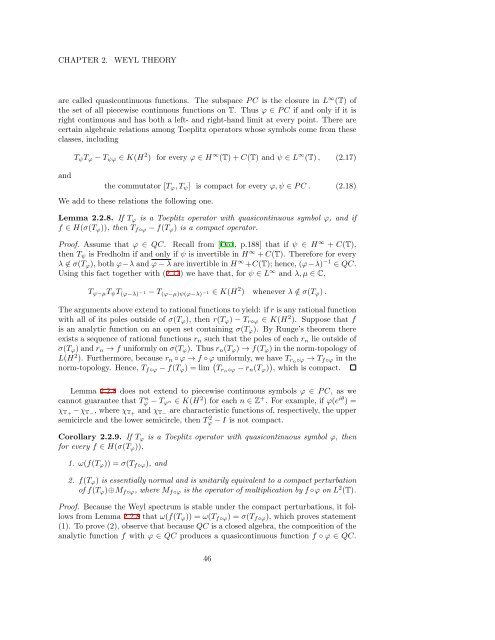Woo Young Lee Lecture Notes on Operator Theory
Woo Young Lee Lecture Notes on Operator Theory
Woo Young Lee Lecture Notes on Operator Theory
Create successful ePaper yourself
Turn your PDF publications into a flip-book with our unique Google optimized e-Paper software.
CHAPTER 2.<br />
WEYL THEORY<br />
are called quasic<strong>on</strong>tinuous functi<strong>on</strong>s. The subspace P C is the closure in L ∞ (T) of<br />
the set of all piecewise c<strong>on</strong>tinuous functi<strong>on</strong>s <strong>on</strong> T. Thus φ ∈ P C if and <strong>on</strong>ly if it is<br />
right c<strong>on</strong>tinuous and has both a left- and right-hand limit at every point. There are<br />
certain algebraic relati<strong>on</strong>s am<strong>on</strong>g Toeplitz operators whose symbols come from these<br />
classes, including<br />
and<br />
T ψ T φ − T ψφ ∈ K(H 2 ) for every φ ∈ H ∞ (T) + C(T) and ψ ∈ L ∞ (T) , (2.17)<br />
the commutator [T φ , T ψ ] is compact for every φ, ψ ∈ P C . (2.18)<br />
We add to these relati<strong>on</strong>s the following <strong>on</strong>e.<br />
Lemma 2.2.8. If T φ is a Toeplitz operator with quasic<strong>on</strong>tinuous symbol φ, and if<br />
f ∈ H(σ(T φ )), then T f◦φ − f(T φ ) is a compact operator.<br />
Proof. Assume that φ ∈ QC. Recall from [Do1, p.188] that if ψ ∈ H ∞ + C(T),<br />
then T ψ is Fredholm if and <strong>on</strong>ly if ψ is invertible in H ∞ + C(T). Therefore for every<br />
λ ∉ σ(T φ ), both φ−λ and φ − λ are invertible in H ∞ +C(T); hence, (φ−λ) −1 ∈ QC.<br />
Using this fact together with (2.17) we have that, for ψ ∈ L ∞ and λ, µ ∈ C,<br />
T φ−µ T ψ T (φ−λ) −1 − T (φ−µ)ψ(φ−λ) −1 ∈ K(H 2 ) whenever λ /∈ σ(T φ ) .<br />
The arguments above extend to rati<strong>on</strong>al functi<strong>on</strong>s to yield: if r is any rati<strong>on</strong>al functi<strong>on</strong><br />
with all of its poles outside of σ(T φ ), then r(T φ ) − T r◦φ ∈ K(H 2 ). Suppose that f<br />
is an analytic functi<strong>on</strong> <strong>on</strong> an open set c<strong>on</strong>taining σ(T φ ). By Runge’s theorem there<br />
exists a sequence of rati<strong>on</strong>al functi<strong>on</strong>s r n such that the poles of each r n lie outside of<br />
σ(T φ ) and r n → f uniformly <strong>on</strong> σ(T φ ). Thus r n (T φ ) → f(T φ ) in the norm-topology of<br />
L(H 2 ). Furthermore, because r n ◦ φ → f ◦ φ uniformly, we have T rn◦φ → T f◦φ in the<br />
norm-topology. Hence, T f◦φ − f(T φ ) = lim ( T rn ◦φ − r n (T φ ) ) , which is compact.<br />
Lemma 2.2.8 does not extend to piecewise c<strong>on</strong>tinuous symbols φ ∈ P C, as we<br />
cannot guarantee that T n φ − T φ n ∈ K(H 2 ) for each n ∈ Z + . For example, if φ(e iθ ) =<br />
χ T+ − χ T− , where χ T+ and χ T− are characteristic functi<strong>on</strong>s of, respectively, the upper<br />
semicircle and the lower semicircle, then T 2 φ − I is not compact.<br />
Corollary 2.2.9. If T φ is a Toeplitz operator with quasic<strong>on</strong>tinuous symbol φ, then<br />
for every f ∈ H(σ(T φ )),<br />
1. ω(f(T φ )) = σ(T f◦φ ), and<br />
2. f(T φ ) is essentially normal and is unitarily equivalent to a compact perturbati<strong>on</strong><br />
of f(T φ )⊕M f◦φ , where M f◦φ is the operator of multiplicati<strong>on</strong> by f ◦φ <strong>on</strong> L 2 (T).<br />
Proof. Because the Weyl spectrum is stable under the compact perturbati<strong>on</strong>s, it follows<br />
from Lemma 2.2.8 that ω(f(T φ )) = ω(T f◦φ ) = σ(T f◦φ ), which proves statement<br />
(1). To prove (2), observe that because QC is a closed algebra, the compositi<strong>on</strong> of the<br />
analytic functi<strong>on</strong> f with φ ∈ QC produces a quasic<strong>on</strong>tinuous functi<strong>on</strong> f ◦ φ ∈ QC.<br />
46













